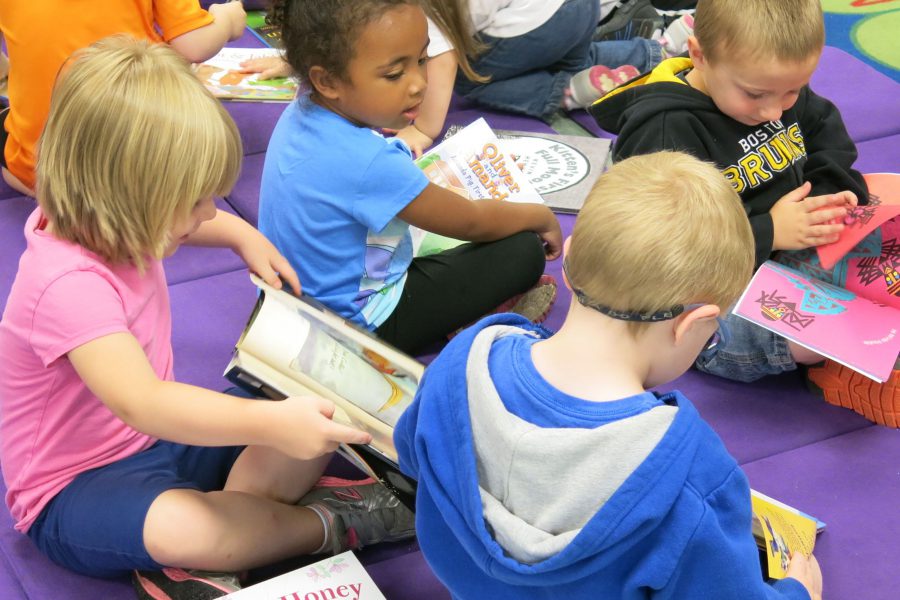
After children have mastered pre-reading skills, the instructional focus shifts to vocabulary, comprehension, and fluency. Most vocabulary is learned indirectly through everyday experiences with both written and oral language. Many children learn new words through read-alouds, but also through conversation. Continue to read to your child, choose books that are a little bit higher in vocabulary than the books your child is reading independently, and expose him or her to new words. Talk with your child, use new and interesting words, and encourage your child to use the new words too. This will help him or her recognize the new words when seen in print. Take your child on new adventures and field trips and point out what you see. These experiences often yield new vocabulary.
What should readers do when coming across a new word for the first time? Word attack strategies include the following: 1. looking for smaller words within the larger newer words; 2. looking for beginnings and endings; 3. applying common sounds; 4. applying less common sounds; 5. using context clues or examining other words in the sentence for definitions, explanations, or hints; 6. going to an outside source, for instance, going to a dictionary, a computer, or another person. For example, for the word reader, first recognize the word read, then recognize the ending -er, then apply the common sound that the letter combination ea makes the letter /e/ sound, and then read the word.
Try playing a game called Stump the Reader. Ask your child to preview some reading material and look for a word that even a strong reader might not know. Then ask your child to write the word on a piece of paper. You, playing the role of the experienced reader, model some word attack strategies to decode that word. Start by looking at smaller words within the larger word. Then look for beginnings and endings. Putting a finger over those pieces of the word may turn a larger word into a much smaller and more manageable word. Try common sounds for the leftover letters, like the letter c making the letter /k/ sound, and try uncommon sounds for the remaining leftover letters, like the letter c making the letter /s/ sound. Go to the dictionary or computer if necessary, or seek an outside expert.
To increase overall vocabulary skills or to increase the number of known words, there are many, many word games to play. Some of those games are traditional word games like Scrabble, Scrabble Jr., Boggle, Boggle Jr., and Upwords. Other games are Make a Face, Memory, Go Fish, Old Maid, and Tic-Tac-Toe using words instead of pictures, letters, or numbers. For Make a Face, choose a word from the read-aloud, other reading, or vocabulary list. Draw a short line for each letter in the chosen word. The child guesses a letter. If correct, the letter is written on the appropriate line. If incorrect, a part of a face is drawn, like the head, eyes, or mouth. The goal is for the child to guess the word before the face is completed. Helpful hints may be given. Such hints include: “Try a vowel,” “Try a letter that is also in your name,” or “Try a letter that makes a certain sound.”
When presenting a book for the first time, preview the story. Look at the cover and look at the pictures inside. Talk about what the story might be about and what the characters might do. Make some predictions. These predictions needn’t come true. Just setting predictions enhances reading for meaning. It sets a purpose for the reading or determines something to find out.
Good readers are curious. Ask questions and encourage your child to ask questions whenever reading or during a read-aloud. Simply ask: “What do you think the characters will do?” or “Why did the characters do what they did?” Open-ended questions are acceptable and preferred. Asking “why” activates more thinking skills, and sparks more discussion, than asking questions that can be answered by “yes” or “no”. When reading Charlotte’s Web by E. B. White, for instance, you can ask: “Why do you think Charlotte decided to help Wilbur by writing words in her web?” Open-ended questions can be used with many stories. Some questions include: “What might happen next?” “Why did the character do that?” “What would you have done?” “How do you think the story will end?” “What do you like best about the story?” “How would you rewrite the story?” Ask your child if she found any part of the reading confusing. Discuss and help to clarify this part.
All readers, including beginning readers, need to pay attention to understanding what they are reading. First, connect a book to familiar parts of your child’s life, such as how the characters are like or unlike people your child knows. Ask: “How is this character like you?” or “Does this character remind you of someone you know?” Specifically you can ask: “How is Peter, in Ezra Jack Keats’s The Snowy Day, like your best friend?” Making text-to-self connections is helpful in relating to the reading and then reading for meaning. Second, find connections in books to what is known about the world. Ask questions like: “What do you know about zoo animals?” These questions will help your child when reading a story about elephants, giraffes, or zebras. Ask questions about how the knowledge of something like how apples grow helps to read a story. An example might consist of how the knowledge of seeds turning into apples helps to understand the Johnny Appleseed stories. Making text-to-world connections are important to building background knowledge and enhancing reading for meaning. Third, connect a story idea to another book the child has read. Fairy tales are great sources for this. An example might consist of these similar books: The Three Little Pigs by Dev Ross, Big Bad Wolf is Good by Simon Puttock, The True Story of the Three Little Pigs by Jon Scieszka , and The Three Little Wolves and the Big Bad Pig by Eugene Trivizas. Ask how the wolf character in one story is similar or different to the wolf character in another story. Making text-to-text connections is crucial to comprehension. It helps to develop summary and response skills.
Ready to read something more substantial that might take more than one sitting? Ready to move onto chapter books? Comprehension is more than just asking questions after the reading. Understanding is enhanced when questions are asked before or during the reading. Ask a simple question, maybe even a retell question, asking for as many details as possible, after a reading session or a chapter is completed, and then ask the same question when picking up the story at the next session. This will bring the reader back into the story refocused on the plot, and will boost reading for meaning for the new session. At the same time, your child will see reading as an activity that includes reading for meaning and not just reading words in print like a list.
A simple game to enhance comprehension is another I Am Thinking game. Here you think of something simple. Usually something in the room works well. Your child asks questions about the object such as: “Is it red?” or “Can it move?” or “Is it bigger than a bread box?” You answer with “yes” or “no”. Your child continues to refine her questions to arrive at the correct answer. Take this further by thinking of a character in a story being read. Your child asks questions about the character, and you answer with “yes” or “no” until the child discovers or determines the correct character or answer.
There are many ways to improve reading fluency. The first rule of thumb is to remember that easy books and old favorites are most appropriate. Reading these books often foster additional practice and improve reading speed. Readers are not stumbling over new words, and are not focusing on the other reading elements, but are focusing on reading smoothly, and in most cases, automatically.
Become actively involved. One of the best ways to do this is through paired reading. This strategy involves two readers reading the same material at the same time. The first key to success here is that the adult reads loud enough for the child to hear both the adult’s voice and his own voice. The second key is that the adult reads slowly and at the child’s reading pace. When adults read with a child like this, and read even the most difficult words correctly, model fluent reading, show some excitement when appropriate, and stop at the punctuation marks, the child hears this and mimics this. Some parents complete all of the reading together. Other parents start reading together, but stop when the child signals he is ready to read alone.
A similar strategy is echo reading. The adult reads a paragraph, sentence, or phrase, and the child reads, or echoes, the same paragraph, sentence, or phrase. The first key to success is to determine how much to read. Some readers can manage echo reading a full paragraph. Others can manage only a phrase. So, start small with phrases, then move to sentences, and then to paragraphs. The second key to success is to make sure the child reader actually reads the passage and doesn’t just recite from memory. Pointing to the words may help.
Another way to improve fluency is the shared reading experience, also called seesaw reading, in which the parent and child take turns reading aloud. This can be done with regular books or with books written at two levels of text. For regular books, look ahead for the easier passages for the child to read. Remember to have fun, change the voice as needed, and laugh when appropriate.
Reading aloud with easier books is one of the best ways for children to improve fluency, so try to increase that amount of time. Invite all family members to take a book to the dinner table so they can read a favorite section aloud. An alternative is to invite family members to read from comic books or newspaper comics, using different voices for the characters. Ask an older child to read to a younger child. This is beneficial because the older child will often find easier books that will interest the younger child. Be warned that just because a book is a picture book doesn’t necessarily mean that it is an easy book. Some picture books have high-level vocabulary words. The older child might want to practice reading out loud a few times before reading to an audience for the first time.
Want to provide reading material at all opportunities? Write notes that your child can easily read. Put these notes beside the bed, on the bathroom mirror, or in a lunchbox to be read at school. These will not only put a smile on your child’s face, but will create additional reading practice without your child even realizing that she is practicing.
- Talk with your child often. Use new words.
2. Read to your child often. Choose books that are written at a higher level than your child’s present reading vocabulary level.
3. Take your child on field trips. Talk about what you see. This helps your child learn more words.
4. Help with word attack strategies. Look for smaller words within words, beginnings and endings, common sounds, less common sounds, and context clues. Consult a dictionary, computer, or an expert.
5. Play Stump the Reader. Ask your child to find a word you might not know and write it down. Model word attack strategies to determine the new word.
6. Play some purchased traditional games. Scrabble, Scrabble Jr., Boggle, Boggle Jr., Upwards, and Password. All are available in retail stores (public libraries often have games, too!).
7. Play some homemade games. Make a Face, Memory, Go Fish, or Tic-Tac-Toe using vocabulary words.
8. Write 20 new words on index cards. Make 5 columns. Group those words so that similar words are together.
9. Challenge each family member to attend dinner with a new word to share with others.
10. Read, read, read. The more a child reads, the more words seen in print, and the more words learned.
Bruce Johnson is an educator, reading specialist at the Merrimack Valley School District in New Hampshire, member of CLiF’s Advisory Board, and author of Helping Your Child Become a Successful Reader: A Guide for Parents. Learn more at www.guidesforparents.wordpress.com.



